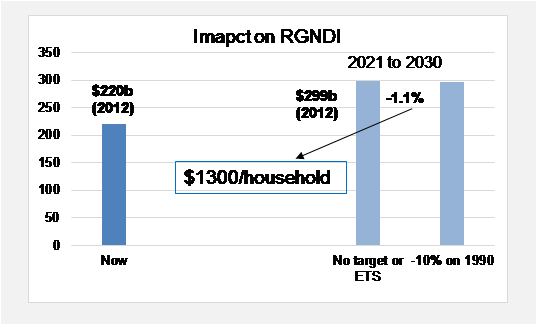Cost of an Emissions Target
Infometrics has recently been involved in estimating the economic impacts on New Zealand of participating in an international agreement to reduce greenhouse gas emissions over the period 2021 to 2030. We looked only at the cost of emissions mitigation to New Zealand, not at the effects (benefits) of avoided climate change. Actions by New Zealand will not affect global warming, but New Zealand may nonetheless wish to set an ambitious emissions reduction target.
A number of scenarios were examined, including different carbon prices and different emissions responsibility targets. The key findings of the research are:
1.For a global price of carbon that reaches $50/tonne by 2030 (exempting agricultural non-CO2 emissions) and a decadal emissions reduction target of -10% on 1990 by 2030, the reduction in New Zealand’s real gross national disposable income (RGNDI) is 1.1% relative to doing nothing. This implies about $1300 per annum in lower consumption per household.
2.Pushing the emissions target to 40% below 1990 by 2030 raises the cost to households to around $1800 per annum. In comparison household consumption is projected to rise by at least $31,000 over the next decade.
3.Only about one fifth of the target is met through domestic abatement; the rest is met by purchasing emission units from offshore. This reflects a relatively high incremental cost in New Zealand of further moves away from fossil fuels.
4.Raising the target simply means that more emission units need to be bought from offshore. A 40% target implies a cost to household consumption of about $1800 per annum.
5.Raising the carbon price in New Zealand above the prevailing global price in order to reduce domestic emissions by a greater amount does not appear to be sufficient to achieve an emissions target of -10% on 1990 levels through domestic action alone – at least not within the current limitations of the model. It also has a potentially high economic cost.
6.Forestry can make a useful short term contribution to reducing New Zealand’s emissions. It would be worthwhile to look more closely at what level of carbon prices would encourage large scale planting.
7.Extending the carbon price in New Zealand to cover agricultural non-CO2 causes a larger fall in GDP, but a smaller fall in national income. Thus it is better to take advantage of abatement opportunities in agriculture that cost less than the international carbon price than to expand agricultural production in order to purchase emissions units from offshore.
Of course all modelling comes with uncertainty – uncertainty about the ease with which consumers and businesses can switch between fuels and switch out of relatively carbon intensive goods and services, uncertainty about new technologies and their cost, uncertainty about actions by the rest of the world, and so on.
However, uncertainty should not be a reason for doing nothing. Instead policy should be cognisant of the risks (favourable and unfavourable) and seek to manage those risks. The results demonstrate that a price of $50/tonne of CO2 with international trading of emission permits does not decimate the New Zealand economy.






